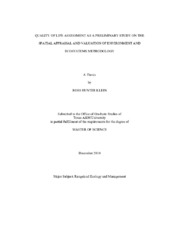| dc.description.abstract | The concept of quality of life (QOL) has been addressed for decades. It was not
until recent times when geographical information systems (GIS) have become available
that a locale-specific approach could be enabled. Even then, analysis to date has been
conducted mostly at the resolution of city or county level. The study presented describes
an innovative methodology that may appraise QOL at finer resolutions, i.e. more localespecific.
The new approach is called Spatial Appraisal and Valuation of Environment
and Ecosystems, or SAVEE.
This thesis research is a proof-of-concept study as the first account of the
SAVEE methodology. It is to set the stage for future studies toward a more
comprehensive framework. In this preliminary study of locale-specific QOL, the
SAVEE methodology was used to illustrate the possibility of handling QOL factors in a
dynamic manner.
The assessment includes three major steps: 1) data preparation, 2) data
conversion and normalization, and 3) combining contributions of factors being
considered.
In the first step, the geospatial data layer of a factor in consideration was input
into GIS to plot a proximity map of the feature, e.g. parks or fire stations. In Step Two,
each factor was first assigned a range of weight according to the location of a site on a
proximity map in terms of the factor’s favorability-unfavorability.
In the third step, weights from each factor were combined in a pair-wise manner,
e.g. park and fire station proximities, or two factors at a time. The weight combining is
done by deploying map algebra formula derived from the expert system algorithm
EMYCIN. The computation was done iteratively until all factors were exhausted. The
final results were coded as a gradient map of an integrated and locale-specific QOL
index in the range of (-1, 1).
In this preliminary study, the City of College Station, Texas was used as the
study site. A set of factors and their respective ranges of weight were used in the study.
By adjusting the incorporation of various factors and their ranges, a series of QOL maps
for the city was generated. The resulting QOL maps indicate what factors and ranges
may or may not have contributions toward a holistic overall picture of the QOL of a city
in the locale-specific context. The SAVEE methodology proved to be successful in
handling qualitative hedonic factors in a locale-specific quantitative manner through the
GIS interface. | en |


